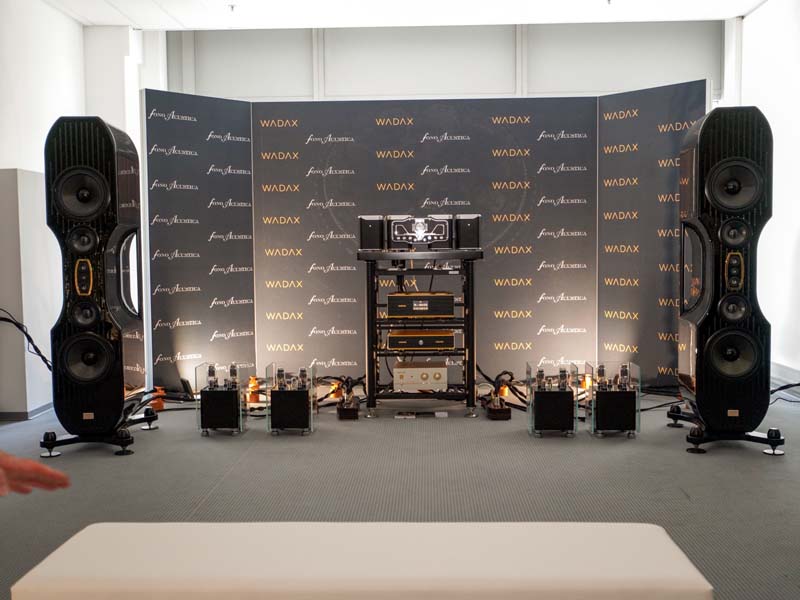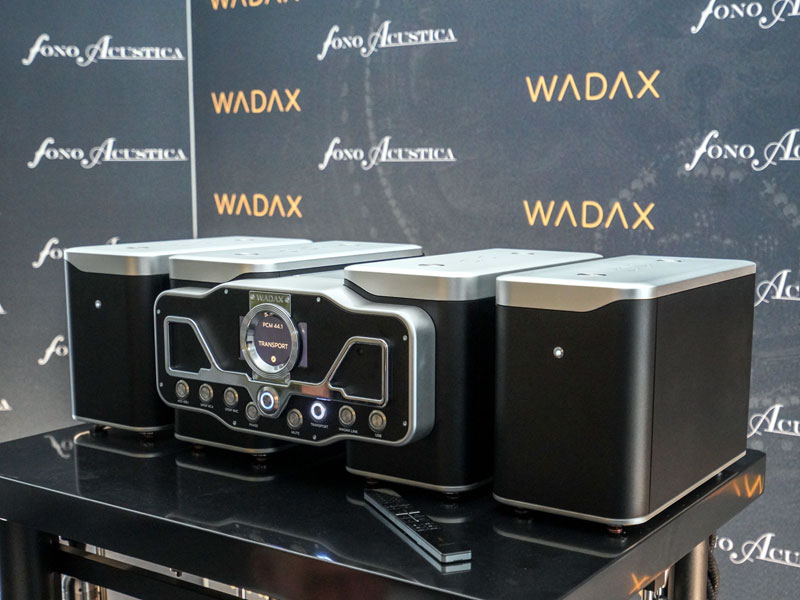High End 2019 • Best of Show

When we were asked that perennial
show-favorite question, “Seen/heard anything good?” this was the system to which
we directed those asking. Last year, Spanish brands Wadax and Fono Acustica, the
room’s co-sponsors, posted the best sound from a system using a digital source, with
Wadax debuting its complete Atlantis digital front-end. This year, Wadax went one better,
delivering what was for us the most impressive performance at the show -- not least
because it did so with another digital front-end, the recently released Wadax Atlantis
Reference DAC along with its dedicated transport. Having already experienced the new
monster converter at a special Audio Exotics launch event in Hong Kong, we were expecting
great things, but we were still taken aback by the results -- not least because the
portents seemed questionable to say the least.
Last year, the Atlantis DAC delivered its
signal to a Robert Koda K15 line stage, feeding a pair of Engström Lars monoblocks,
driving an Avantgarde Trio spherical-horn/active Basshorn system. This year, much of the
chain remained the same with the Fono Acustica Virtuoso cables hooking together the latest
Robert Koda K15EX line stage ($58,000) and Engström Lars amplifiers ($68,750 per pair),
only this time around they were being asked to drive the massive Kharma Exquisite Grand
Signature loudspeakers ($280,000 per pair), passive monsters with seven drivers a side,
including a pair of 12” bass units. Even at a claimed 92dB sensitivity, that’s a
world away from the part-active Trio rig, with its 107dB efficiency, and it looks like an
awful lot of loudspeaker for 42 watts of power. Presumably, Wadax and Fono Acustica
thought so too, as they took the precaution of ensuring the presence of a second set of
Lars monoblocks. Even so, we approached the room for the first time fearing a system that
might be more Florence Foster Jenkins than Frederica von Stade. As it was, we needn’t
have worried, and right from the start this system was clearly very special indeed.

As impressive as the line stage, speakers,
cables and the single set of Lars monos -- amps that proved quite sufficient to the task
-- undoubtedly were, the star of this particular show was the monumental Atlantis
Reference DAC ($130,000). We’d seen the pictures and been warned, but believe us when
we say that nothing quite prepares you for the reality of this massive,
multi-chassis alloy monster. Spread across a single platform, it measures fully 866mm or
almost a yard wide, with each block being very nearly a foot tall and quite a bit deeper
than that. Fortunately, you can array the twin power supplies beneath the head unit,
allowing it to be arranged vertically in a standard rack, but there’s no escaping the
visual impact of the creature when it’s arrayed in a single rank. Totally dual mono
and fully balanced in topology, this is also the first dual-differential implementation of
the Wadax MusIC technology, the innovative and musically impressive error-correction
system, a load sensitive, algorithmic feed-forward based technology that corrects for
DAC-induced time and phase errors. Massive, heavily filtered and regulated external power
supplies feed extensive distributed regulation throughout the circuitry, while card-cage
construction ensures that each critical circuit block is field serviceable or updatable.
That requires no fewer than 23 individual circuit boards, ten individual transformers and
over 5500 discrete components to implement -- which along with the carved from solid
chassis construction and extensive mechanical grounding helps explain the huge cost.
One thing that rammed home the musical
superiority of this system was the choice of demonstration program material. The Wadax
Reference DAC accepts native DSD from a dedicated Atlantis transport ($45,000) via a new
triple AES/EBU connection that replaces the dual Ethernet hookup on the standard Atlantis.
Dedicated DSD decoding rather than conversion to PCM really shows the musical benefits of
the SACD format, and it was no surprise that much of the music played on this system was
from the high-res discs. Musical performance was astonishingly natural and unforced,
devoid of the tell-tale digital fingerprints of normal optical disc replay or the rounding
warmth and temporal imprecision of analog sources. Here was a sound that was neither
digital nor analog in nature -- it was simply music. Smaller-scale acoustic pieces sounded
almost preternaturally real, while the human, organic nature of the sound was immediately
appealing and communicative, with no audible trace of the digital or mechanical process
that had produced it.
Playing the familiar Benedetti
Michelangeli/Giulini Beethoven First Piano Concerto, a recording that’s become an
acid test of system performance, both for its inherent musicality and its availability
across all formats, the SHM-SACD version [Deutsche Grammophon UCGG-90440] displayed not
only Giulini’s masterful control of orchestral balance, level and tempo, but his
soloist’s quicksilver brilliance and expressive range. Here was note weight and tonal
density, dynamic shading and dynamic impact, to swoon over. One practiced pianist, bowled
over by the orchestral opening, sat in slack-jawed wonder at the fluid articulation and
subtle weighting of Benedetti Michelangeli’s playing, the depth of the conversation
between soloist and orchestra, and the fluency of the performance as a whole.
Familiar performances as varied as the Du
Pré/Elgar Cello Concerto SACD [EMI 50999 9 55905 2] and Eleanor McEvoy’s Yola
SACD [Mosco EMSACD1] didn’t so much reveal new nuance as simply throw off the
shackles of reproduction, the music and performances standing bold and separate from the
system reproducing them. Nor was the effect limited solely to SACD -- with CD, UHQCD and
even Glass CD all getting their turn. In each and every case, demonstration disc or
visitor’s request, listeners simply forgot the system, bowled over by the sheer
natural accessibility of the music being produced.
Perhaps the last word should go to an
industry insider and analog diehard who asked that fateful question. We sat beside him as
he listened to familiar track after familiar track, and he turned to us and opined,
“So, it doesn’t have to be vinyl!” Who knew that the road to
Damascus ran through Munich's MOC? |